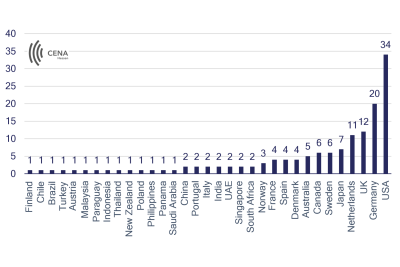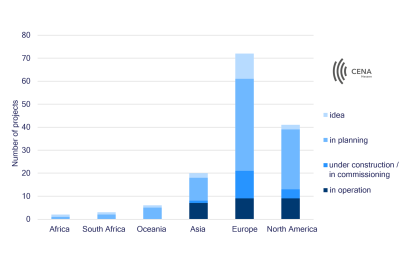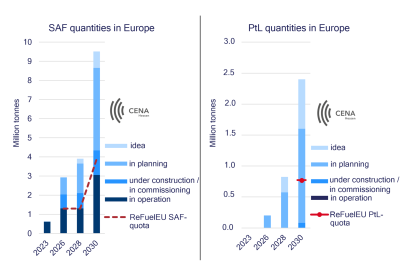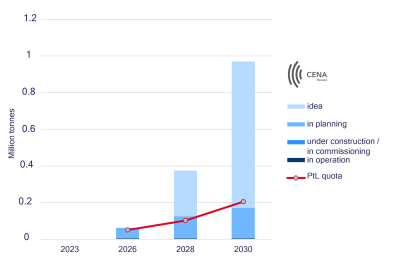The CENA SAF Outlook 2024-2030 provides insights into future trends and developments in global activities on the SAF market. It makes it possible to estimate the expected SAF production volumes and the additional potential for sustainably produced fuels (synfuels).

Sustainable Aviation Fuel Outlook
Outlook for the planned global production of sustainable aviation fuel by 2030
Overview of the results:
- State October 2023: 144 active SAF projects worldwide, 20 of which are in Germany
- Announcement for 2030: production volume of almost 30 million tonnes of SAF worldwide, of which around 1.5 million tonnes from Germany
- Announced global production volume represents only around 5-10 percent of the kerosene used in aviation worldwide
- HEFA share worldwide at 90 percent in 2023; around 70 percent in 2030
- Technological focus in Germany will also remain on power-to-liquid (PtL) in the future
- Fulfillment of the European SAF quota possible, but mainly from biogenic processes
- European and German PtL quota probably not achievable
The English version of the CENA SAF-Outlook 2024-2030 - An analysis of volumes, technologies and production sites for sustainable aviation fuels will be published in February 2024.
Receive a notification of publication by e-mail:
CENA SAF-OUTLOOK 2024-2030 - AN ANALYSIS OF VOLUMES, TECHNOLOGIES AND PRODUCTION SITES FOR SUSTAINABLE AVIATION FUELS
Sustainable aviation fuels (SAF) are a key component for the defossilization of aviation. From 2025, mandatory SAF quotas will apply in Europe, which are defined by the ReFuelEU Aviation Regulation. In Germany, the Federal Immission Control Act (BImSchG) currently still requires the blending of power-to-liquid kerosene (PtL). Despite these requirements, sustainable aviation fuels are only available in small quantities to date. A sufficient supply of SAF is therefore crucial to making aviation more sustainable and ensuring that the EU’s climate protection targets are met.
The CENA SAF Outlook 2024-2030 is the first to provide an overview of current and forecast SAF production volumes up to 2030. It shows which technologies will be used in SAF production and when, and how the development status (degree of implementation) of the respective projects can be assessed. This is done against the background of examining whether the quotas at national and EU level can be met with the announced production capacities. For this purpose, publicly available sources were evaluated and compared with company data collected specifically for this purpose.
MOST SAF PROJECTS IN EUROPE AND THE USA
By the reporting date of October 31, 2023, 144 active projects and plans for the production of SAF had been identified in 33 countries worldwide. Around half of these are in Europe, followed by North America and Asia. Most SAF projects are located in the USA (N=34), followed by Germany (N=20) and the United Kingdom (N=12). In more than half of the countries with SAF projects, there are only one or two projects. The projects analyzed are in different project phases, ranging from the idea, planning, construction and commissioning through to ongoing operation.
GLOBALLY ALMOST 30 MIO. TONNES OF SAF ANNOUNCED FOR 2030
CENA's comprehensive data collection and analysis shows that almost 2 million tonnes of SAF were produced worldwide in 2023. Our forecasts indicate that this volume will increase to 9 million tonnes in 2026, to around 18 million tonnes in 2028 and to almost 30 million tonnes in 2030. This corresponds to around 5-10 percent of the kerosene used in air traffic worldwide. In all regions of the world, a large increase in production volumes is expected from 2026.
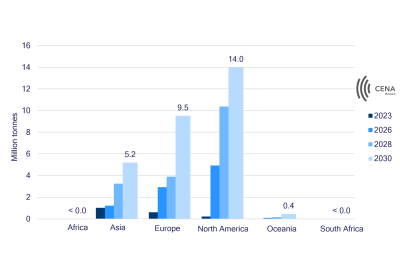
North America is the largest SAF producer, followed by Europe and Asia. The share of the announced annual production of SAF "Made in Germany" amounts to 1.5 million tonnes by 2030. This would correspond to an average plant size in Germany of 75,000 tonnes in 2030.
HEFA WILL CONTINUE TO BE THE PREDOMINANT TECHNOLOGY IN THE FUTURE
Various production paths are used for the production of SAF. The most important worldwide is currently HEFA (Hydrotreated Esthers and Fatty Acids) - more than every third SAF project worldwide uses this process. Almost as many projects are PtL plants, which, however, have significantly lower degrees of implementation and production volumes. Alcohol-to-jet (AtJ) projects currently have a global share of 15 percent, while the methanol-to-jet (MtJ) route is by far the least utilized process. It should be noted here that the further processing of methanol into kerosene is not yet approved. However, approval seems realistic by 2025/2026.
In terms of production volumes, there is an even stronger focus on the HEFA process: in 2023, around 90 percent of SAF production worldwide was produced using HEFA. This share will decrease to 70 percent by 2030 due to the growing production volume from the AtJ and PtL processes. Overall, there is a strong global interest in biogenic processes, while e-fuels will continue to account for the smallest share of announced SAF production worldwide in 2030.
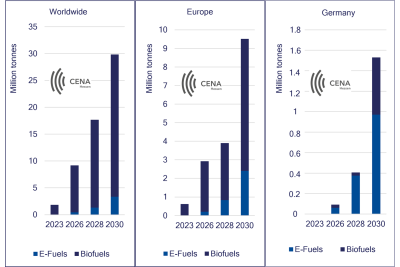
In Germany, the technological focus is clearly on Fischer-Tropsch synthesis (PtL): 18 out of 20 SAF projects in Germany are PtL projects. However, most of these are still in the planning or in the project idea stage. Only six plants are already under construction or in operation as research and demonstration plants.
CAN THE QUOTAS BE MET AT NATIONAL AND EU LEVEL?
According to the ReFuelEU Aviation Regulation, at least two percent of the fuel used at airports in the EU must be produced from sustainable sources from 2025. The distributors of kerosene are obliged to do so. By 2050, this proportion should gradually increase to 70 percent, of which at least 35 percent should be derived from non-biogenic sources. Fulfilling the European SAF quota from mainly biogenic processes appears to be possible based on the announced production projects and taking into account the degree of implementation of the projects in the EU. However, it seems unlikely that the European PtL quota will be met.
The PtL quota embedded in the Federal Immission Control Act stipulates that 0.5 percent PtL kerosene must be added to the kerosene distributed in Germany in 2026, one percent in 2028 and two percent in 2030. The blending obligation is directed at the distributors, i.e. not usually directly at the airlines. It is currently unclear whether this national regulation will continue to apply in light of the EU ReFuelEU Aviation Regulation. Based on the amount of kerosene used in Germany in the base year 2019, with an assumed growth rate of one percent per year from 2026, this corresponds to a demand of around 50,000 tonnes of PtL kerosene in 2026, 100,000 tonnes in 2028 and 200,000 tonnes in 2030. Penalties must be paid in the event of non-compliance.
The CENA SAF-Outlook 2024-2030 clearly shows that this quantity will not be available in time. None of the projects in Germany that envisage the production of larger quantities have reached a level of implementation that makes the start of operations in 2025 appear realistic. Due to the lack of final investment decisions and long lead times for approvals, engineering work, clarification of financing, construction and commissioning, it is doubtful whether sufficient production can be achieved in time. There is therefore still a need for action to ensure satisfactory PtL production in Germany and Europe.
The following options for action are available to prevent the PtL quota from not being met in Germany:
- Imports from other European and non-European countries
- Demand for book & claim procedure in the EU to determine quota fulfillment for airlines
- Postponement of the quota for 2026 to a later date
- Increase willingness to invest through an appropriate return on investment
- Adequate "negative incentivization" through higher penalties
- Creation of incentives for the use of SAF in taxation, such as the aviation tax
- Investment security for systems through appropriate regulation
- Simplified requirements and acceleration of approval processes by the EU Commission
- Increased coordination and bundling of funding at federal level
The English version of the CENA SAF-Outlook 2024-2030 - An analysis of volumes, technologies and production sites for sustainable aviation fuels will be published in February 2024.
Receive a notification of publication by e-mail:
